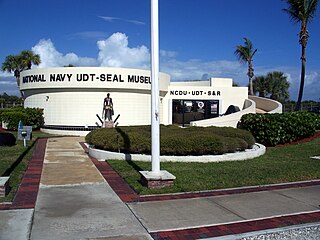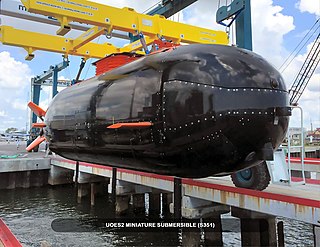
The United States Navy Sea, Air, and Land (SEAL) Teams, commonly known as Navy SEALs, are the U.S. Navy's primary special operations force and a component of the Naval Special Warfare Command. Among the SEALs' main functions are conducting small-unit special operation missions in maritime, jungle, urban, arctic, mountainous, and desert environments. SEALs are typically ordered to capture or kill high-level targets, or to gather intelligence behind enemy lines. SEAL team personnel are hand selected, highly trained, and possess a high degree of proficiency in direct action (DA), and special reconnaissance (SR), among other tasks like sabotage, demolition, intelligence gathering, and hydro-graphic reconnaissance, training, and advising friendly militaries or other forces.

A frogman is someone who is trained in scuba diving or swimming underwater in a tactical capacity that includes military, and in some European countries, police work. Such personnel are also known by the more formal names of combat diver, combatant diver, or combat swimmer. The word frogman first arose in the stage name the "Fearless Frogman" of Paul Boyton in the 1870s and later was claimed by John Spence, an enlisted member of the U.S. Navy and member of the OSS Maritime Unit, to have been applied to him while he was training in a green waterproof suit.

A dry deck shelter (DDS) is a removable module that can be attached to a submarine to allow divers easy exit and entrance while the boat is submerged. The host submarine must be specially modified to accommodate the DDS, with the appropriate mating hatch configuration, electrical connections, and piping for ventilation, divers' air, and draining water. The DDS can be used to deploy a SEAL Delivery Vehicle submersible, Navy divers, or Combat Rubber Raiding Craft (CRRC).

A diver propulsion vehicle (DPV), also known as an underwater propulsion vehicle, sea scooter, underwater scooter, or swimmer delivery vehicle (SDV) by armed forces, is an item of diving equipment used by scuba divers to increase range underwater. Range is restricted by the amount of breathing gas that can be carried, the rate at which that breathing gas is consumed, and the battery power of the DPV. Time limits imposed on the diver by decompression requirements may also limit safe range in practice. DPVs have recreational, scientific and military applications.

A midget submarine is any submarine under 150 tons, typically operated by a crew of one or two but sometimes up to six or nine, with little or no on-board living accommodation. They normally work with mother ships, from which they are launched and recovered and which provide living accommodation for the crew and support staff.

The United States Naval Special Warfare Command (USNSWC), also known as NAVSPECWARCOM and WARCOM, is the naval component of United States Special Operations Command, the unified command that oversees and conducts the nation's special operations and missions.

Human torpedoes or manned torpedoes are a type of diver propulsion vehicle on which the diver rides, generally in a seated position behind a fairing. They were used as secret naval weapons in World War II. The basic concept is still in use.

The Advanced SEAL Delivery System (ASDS) was a midget submarine operated by the United States Navy and United States Special Operations Command. It provided stealthy submerged transportation for United States Navy SEALs from the decks of nuclear submarines for use as an insertion platform for covert and clandestine special operations missions. The ASDS was canceled in 2009 due to cost overruns and reliability issues, after the prototype was destroyed in a fire in 2008. As of 2019, the Navy plans to replace the ASDS with the Dry Combat Submersible, a similar midget submarine being developed by Lockheed Martin.

A wet sub is a type of underwater vehicle, either a submarine or a submersible, that does not provide a dry environment for its occupants. It is also described as an underwater vehicle where occupants are exposed to ambient environment during operations. The watercraft is classified as medium-sized or small vessel. This type of submarine differs from other underwater personal transport devices by the fact that it has a hull around it and it is not a "bare bones" design.

The National Navy UDT-SEAL Museum, also known as the Navy SEAL Museum, is located in St. Lucie County, just outside Fort Pierce, Florida. It houses exhibits to inform and educate on the role of Navy Underwater Demolition Teams (UDT) and Sea, Air, Land (SEAL) teams. The museum also preserves the history of the SEALs.
Naval Special Warfare Group 3 (NSWG-3), based at the Naval Amphibious Base Coronado in California, was one of six constituent formations of the United States Naval Special Warfare Command. Until 2008, NSWG-3 was composed of two SEAL Delivery Vehicle Teams: SDVT-1 in Pearl Harbor and SDVT-2 in Little Creek. In 2008, SDVT-2 was disestablished and merged into SDVT-1, which was then now headquartered in Pearl Harbor and operated detachments in Pearl Harbor and Little Creek. SDV Teams are SEAL teams with an added underwater delivery capability. SDVT-2 was reactivated on 8 March 2019. NSWG-3 was deactivated alongside NSWG-10 in August 2021 and replaced by Naval Special Warfare Group 8 which took in all units previously under NSWG-3 and NSWG-10.

The US employs divers in several branches of the armed forces, including the navy, army, marines, air force and coast guard.
Operation Thunderhead was a highly classified combat mission conducted by U.S. Navy SEAL Team One and Underwater Demolition Team 11 (UDT-11) in 1972. The mission was conducted off the coast of North Vietnam during the Vietnam War to rescue two U.S. airmen said to be escaping from a prisoner of war prison in Hanoi. The prisoners, including Air Force Colonel John A. Dramesi were planning to steal a boat and travel down the Red River to the Gulf of Tonkin.

The Cosmos-class submarine, officially Cos.Mo.S MG-110 locally designated as X-Craft, are the class of midget submarines designed by the Italian firm Cos.Mo.S, in Karachi Naval Dockyard in Karachi, Sindh, Pakistan.
CosMoS CE2F were a series of swimmer delivery vehicles (SDV) built by M/s Cos.Mo.S Spa. which was based in Livorno, Italy.
A semi-submersible naval vessel is a hybrid warship, that combines the properties of a surface ship and submarine by using water ballast to partially immerse and minimize its above-waterline profile, thereby improving its stealth characteristics when in hostile waters. The USS Monitor was an antecedent to such craft with its low-profile deck and gun turret. Russian and North Korean semi-submersible naval vessels evolved from torpedo boats and special forces boats that could partially submerge to perform their missions. The US Navy SEALs use such vessels for clandestine special forces actions. Efforts to embody advantageous surface-ship characteristics into submarines have not been widely adopted.

The Shallow Water Combat Submersible (SWCS) is a crewed submersible and a type of swimmer delivery vehicle that is planned to be used to deliver United States Navy SEALs and their equipment for special operations missions. It will replace the current Mark 8 SEAL Delivery Vehicle. The Navy planned to introduce the SWCS in 2018, although "slippage in the development" has delayed its introduction until 2019. In 2020, the U.S. Navy stated that it was undergoing sea trials and testing. As of October 2018, two subs have been delivered to the Navy while another two were in production. The SWCS will serve alongside the Dry Combat Submersible (DCS), a midget submarine with a dry interior being developed by Lockheed Martin as a replacement for the cancelled Advanced SEAL Delivery System (ASDS).

The Dry Combat Submersible (DCS) is a midget submarine delivered to USSOCOM by Lockheed Martin.
Submarine rescue is the process of locating a sunk submarine with survivors on board, and bringing the survivors to safety. This may be done by recovering the vessel to the surface first, or by transferring the trapped personnel to a rescue bell or deep-submergence rescue vehicle to bring them to the surface. Submarine rescue may be done at pressures between ambient at depth, and sea level atmospheric pressure, depending on the condition of the distressed vessel and the equipment used for the rescue. Self-rescue of submarine personnel by buoyant free ascent at ambient pressure is considered submarine escape. Survivors may require recompression treatment for decompression illness.





















